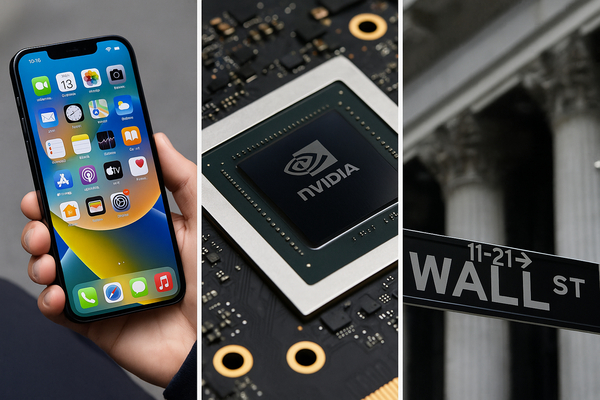
The market’s recent mood can best be described as selective optimism: major indices inched higher while investors parsed mixed signals from the biggest technology names. The S&P 500 was up approximately 0.2% in early afternoon trading, and headline activity has been concentrated in a handful of companies that will determine the next leg of the rally.
Market Pulse and the Big Names Driving Direction
Apple remains center stage after the iPhone 17 unveiling. The new device has supporters pointing to stronger holiday demand and a healthier upgrade cycle, while other data points hint at cooling momentum: one report noted that certain iPhone 17 sales metrics are losing steam even as shares have rallied roughly 6 months into a recovery that lifted them from lows below $230. In premarket trade Apple was quoted at around $255.71. Jefferies has reiterated a Hold with a $206 target, while Wedbush recently set a more bullish target of $310 for 2025 — evidence of the wide range of Wall Street views.
At the same time, Microsoft conversations have taken a turn toward skepticism. One analyst piece argued Microsoft may be overvalued given intensifying competition and the practical challenges of monetizing AI at the scale investors expect.
On the AI hardware front, Nvidia continues to command attention. The company reported about 56% revenue growth in a recent disclosure, and quotes showed Nvidia trading near $183.24 in early action. That growth underpins bullish technical and fundamental narratives even as a growing chorus of investors questions whether client AI budgets can sustain current trajectories.
Chip-equipment and semiconductor players also reported notable analyst activity. Deutsche Bank raised Lam Research’s price target to $150 from $100, citing stronger memory demand and foundry exposure. Intel received fresh attention when Deutsche Bank lifted its price target to $30, helping fuel a rally that pushed the stock toward its 52-week highs.
Results, Upgrades and Big Balance-Sheet Moves
Several corporate updates and analyst calls this week provide concrete numbers investors can act on. Progress Software (PRGS) beat expectations: Q3 revenue came in at about $249.8 million versus consensus near $240 million, and adjusted EPS was $1.50 versus estimates of $1.30. Progress disclosed Annualized Recurring Revenue of $849 million, a 47% year-over-year increase, and management raised full-year guidance. Those are meaningful beats for a software name tying product positioning to AI and RAG-enabled use cases.
Strategy Inc. (MSTR) continued to expand its bitcoin treasury, buying 196 BTC for roughly $22.1 million and lifting total holdings to about 640,031 BTC. One headline noted Bitcoin trading near $114,000 after the purchase — a reminder of how crypto flows can move correlated equities.
Other corporate moves with numeric context: Progress Software’s revenue growth of 40% year-over-year (reported as $250 million in another release), PRGS’s ARR growth, and the double-digit target revisions across semiconductor equipment names all create a data-rich set of cues for portfolio managers.
Where Investors Should Focus Next
With headlines and data points stacking up, here are the practical items that matter most over the coming weeks:
- Apple order and channel data: Watch incoming iPhone 17 sell-through and carrier order updates. They will determine whether the recent rally has a solid fundamental base or is primarily sentiment-driven.
- AI capex signals from hyperscalers: Nvidia’s expansion and client investments — including ties to OpenAI and cloud partners — remain the primary demand drivers for AI chips and related supply chains.
- Semiconductor equipment spend: Upgrades from research shops (for example, Lam Research’s new target increase to $150) suggest WFE growth is accelerating, so monitor bookings and memory capex cadence closely.
- Earnings beats and recurring revenue momentum: Names that show durable ARR growth and higher-margin recurring revenue (Progress Software’s $849M ARR and Q3 beats) should outperform peers if macro conditions stay stable.
Finally, macro and market breadth matter: the S&P 500 has advanced roughly 33% since its April lows, and strategists are watching key index milestones (some forecasts mentioned targets around 6,500 and a bull case near 7,000). That means selectivity will be critical — big winners may keep powering headline indices while many other components lag.
Actionable takeaway: focus on names that combine tangible revenue beats, clear AI or recurring revenue exposure, and confirmatory customer or backlog data. Price targets, technical levels, and corporate treasury activity provide useful signals, but prioritize companies that can show sustained demand and margin leverage in the quarters ahead.












